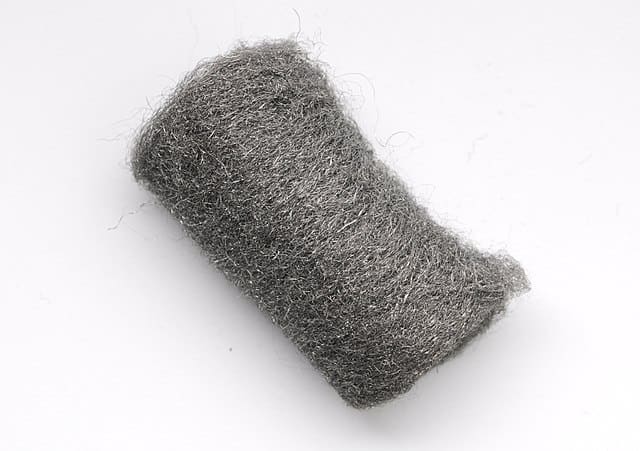Time to clean your guitar up!
A boring task? I don’t think so!
It is nothing but an experience itself. Just you, your guitar, and your favorite tunes blasting through the speakers.
Nothing can go wrong.
Oh, wait! What the hell are you doing!?
No! You weren’t supposed to clean the guitar with a ball of steel wool!
Do you want to know why?
Steel wool is not safe at all. The steel dust that the wool leaves behind after cleaning could get permanently attached to the pickups, which are magnetic, and damage the instrument. There are better alternatives to choose from, so stay away from steel wool at all costs.
Elude this element, please. We are begging you!
If you are still not convinced, it is because you haven’t read the full article yet.
Stick with us, and find out why cleaning a guitar with steel wool is such a bad idea.
Should you use steel wool on guitar frets or fretboard?
We highly encourage you not to use steel wool on the guitar fret. To be honest, we encourage you not to use it at all, no matter which section of the guitar you are trying to clean up.
Some people believe cleaning the fretboard with steel wood will not lead to any negative outcome. However, even if the fretboard is cleaned up assertively, you run the risk of ruining other parts of your guitar.
We encourage you to use other alternatives instead of steel wool. If you want to know which to use specifically, we are listing them below.
Can steel wool shavings ruin your guitar pickups?
One of the reasons we recommend not using steel wool when cleaning up your guitar is because of the shavings that fall when rubbing the steel wool against the instrument.
When cleaning with a ball of steel wool, the material it is made of will start to crumble. In other words, the little steel shards will fall off.
This could ruin different areas of your instrument, including the pickups.
After all, most pickups have magnetism, which means that the metal parts will be attracted by them.
Pickups with magnetic poles attract metal towards them. This wouldn’t be much of an issue if it wasn’t for one particular detail.
The chances of the steel pieces passing through the coil wire are high. They could open through the circuit (and even cut it completely), which would create drastic problems for your guitar.
Bear in mind that although this scenario is very likely to happen, it doesn’t mean it will always occur.
In fact, many people claim they have cleaned their instruments with steel wool without noticing any damage or problems at all (as we have already mentioned).
Nonetheless, we believe you should still keep away from using such material. There are other alternatives that will not cause damage at all.
Is there a way of protecting your pickups when using steel wool?
Naturally, there are some tips to implement and avoid regrets.
First of all, we recommend using a vacuum cleaner as soon as you finish cleaning with the steel wool. That way, you are removing all the little steel pieces that could be left after cleaning up.
Also, a pressurized air blower could work flawlessly. What’s important here is that the tiny steel particles are removed completely.
Another tip to implement is covering the guitar pickups with painter’s tapes before cleaning the fretboard with a steel wool piece.
Once the job is done, simply remove the painter’s tape carefully.
In addition, use a dry cloth to cover the pickup. After all, certain tapes could damage the pickups due to their glue.
The last tip to protect your guitar pickups from steel wool is simply not using steel wool at all! Trust us, it is not worth the effort.
What to do if steel wool shavings got stuck on your pickups?
As we mentioned in the paragraph above, you could try cleaning the guitar pickups with a vacuum cleaner.
That way, you make sure every tiny piece of metal is discarded from the guitar’s circuits.
Another thing you could try is dismantling your guitar and taking away every metal part that interferes with the pickups and circuits.
This is a daunting task; and a time-consuming one. However, if you believe there are no alternatives, then go for it.
Just use a screwdriver to remove the screws, and separate every part of the guitar.
Bear in mind that with “every part” we are just referring to the pickguard and the strings. Long story short, anything that could interfere with the cleaning process.
After that, check if there are small steel pieces left inside the guitar. Use a magnet to extract them.
Lastly, if you believe the guitar’s running a high risk of being damaged, we recommend taking it to a luthier.
Having a professional do the job for you costs money, but more often than not, it is the best option you can choose from.
Alternatives to steel wool for cleaning a guitar
Now, let’s focus on the alternatives so you avoid risking ruining your pickups.
The very best alternative is cleaning the fretboard with a steel cleaner or 3M. Gently pass a dry cloth against the fretboard and remove all the dirt.
To protect the wood from the cleaner (and to focus solely on the metal parts), simply cover the wood with a fretboard shield or any type of tape.
Not to mention, there is a variety of oils, guitar polishes, and fret butter to choose from. They work similarly to sprays.
Just pass them over the guitar parts and clean them with a towel.
Any of these methods are safer than using steel wool.
Unless you are absolutely sure about your instrument, we encourage you not to try it at all.
With that being said, good luck polishing that beauty of a guitar you have.

Hello there, my name is Ramiro and I’ve been playing guitar for almost 20 years. I’m obsessed with everything gear-related and I thought it might be worth sharing it. From guitars, pedals, amps, and synths to studio gear and production tips, I hope you find what I post here useful, and I’ll try my best to keep it entertaining also.





